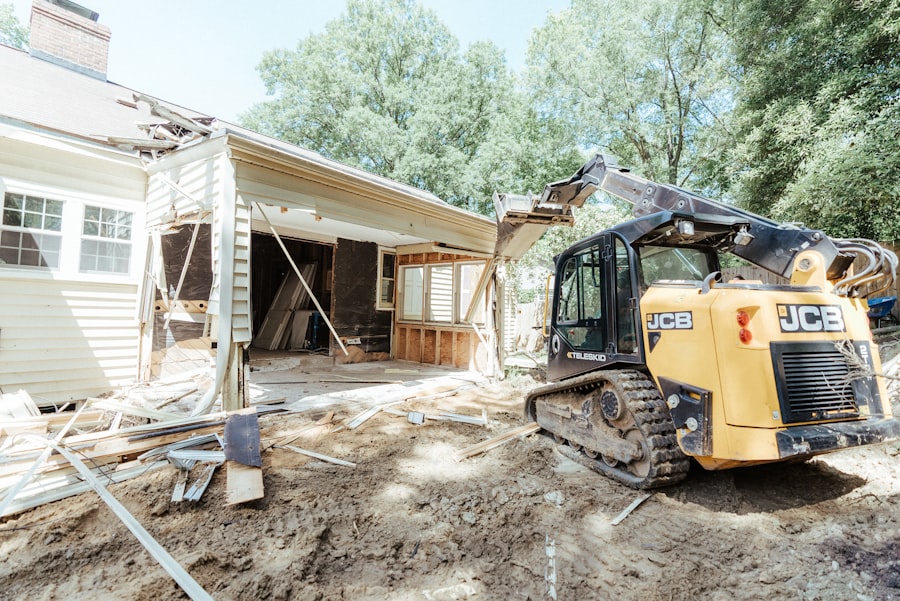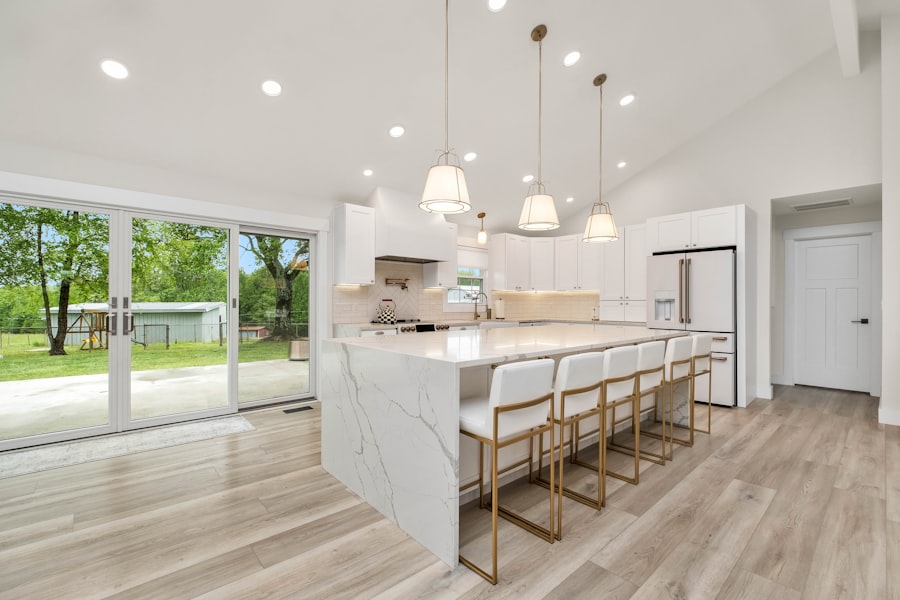Embarking on a kitchen and bathroom remodel is an exciting yet daunting task that requires careful planning and consideration. The first step in this journey is to define your goals and objectives. Are you looking to enhance functionality, improve aesthetics, or increase the value of your home?
Understanding your primary motivations will guide your decisions throughout the remodeling process. For instance, if your goal is to create a more functional kitchen for family gatherings, you might prioritize an open layout with an island for additional seating and workspace. Conversely, if you are focused on increasing resale value, you may want to consider timeless designs and high-quality materials that appeal to a broad range of potential buyers.
Once you have established your goals, it’s essential to assess the current layout and structure of your kitchen and bathroom. Take measurements and note any existing plumbing or electrical configurations that may impact your design choices. This assessment will help you identify potential challenges and opportunities within the space.
For example, if your bathroom has a small footprint, you might explore options like wall-mounted vanities or corner sinks to maximize usability without sacrificing style. Additionally, consider how the flow of the space can be improved; ensuring that the kitchen allows for easy movement between cooking, cleaning, and dining areas can significantly enhance the overall experience.
Key Takeaways
- Careful planning is essential for a successful kitchen and bathroom remodel.
- Select durable, high-quality materials and fixtures that suit your style and needs.
- Optimize layout to maximize space and improve functionality.
- Incorporate energy-efficient appliances and features to save costs and reduce environmental impact.
- Hire experienced professionals and manage budget and timeline to ensure a smooth renovation process.
Choosing the Right Materials and Fixtures
Selecting the right materials and fixtures is crucial in achieving both functionality and aesthetic appeal in your remodeled spaces. When it comes to countertops, for instance, granite and quartz are popular choices due to their durability and low maintenance requirements. Granite offers a unique, natural look with its varied patterns, while quartz provides a more uniform appearance and is available in a wider range of colors.
In bathrooms, materials like porcelain tiles are favored for their water resistance and ease of cleaning, making them ideal for wet areas such as showers and floors. In addition to countertops and tiles, fixtures play a significant role in defining the character of your kitchen and bathroom. Choosing faucets, sinks, and lighting that complement your overall design theme can elevate the space dramatically.
For example, a sleek, modern faucet paired with a farmhouse sink can create a striking contrast in a contemporary kitchen. Similarly, in bathrooms, opting for vintage-style fixtures can add charm and character to a more traditional design. It’s also important to consider the functionality of these fixtures; for instance, a pull-down kitchen faucet can enhance usability during meal prep and cleanup.
Maximizing Space and Functionality

Maximizing space and functionality is particularly important in kitchens and bathrooms, where efficient use of square footage can significantly impact daily routines. In kitchens, consider incorporating multi-functional furniture such as an island that serves as both a cooking area and a dining space. This not only optimizes the available space but also encourages social interaction during meal preparation.
Additionally, utilizing vertical storage solutions like tall cabinets or open shelving can help keep countertops clutter-free while providing easy access to frequently used items. In bathrooms, space-saving solutions are equally vital. Floating vanities can create an illusion of more floor space while providing essential storage underneath.
Furthermore, installing recessed shelving in shower areas can offer convenient storage for toiletries without encroaching on valuable space. Another effective strategy is to use mirrors strategically; large mirrors can reflect light and create a sense of openness, making even the smallest bathrooms feel more expansive. By thoughtfully considering how each element contributes to the overall functionality of the space, you can create an environment that meets your needs while remaining aesthetically pleasing.
Incorporating Energy-Efficient Features
| Energy-Efficient Feature | Typical Energy Savings (%) | Average Installation Cost | Payback Period (Years) | Environmental Impact |
|---|---|---|---|---|
| LED Lighting | 75-85% | Low | 1-2 | Reduces electricity consumption and waste |
| High-Efficiency HVAC Systems | 20-40% | Medium to High | 3-7 | Lower greenhouse gas emissions |
| Solar Panels | Variable (depends on location) | High | 7-12 | Generates renewable energy, reduces fossil fuel use |
| Insulation Improvements | 10-50% | Medium | 3-5 | Reduces heating and cooling energy demand |
| Energy-Efficient Windows | 10-25% | Medium to High | 5-10 | Improves thermal regulation, reduces energy loss |
| Smart Thermostats | 10-15% | Low to Medium | 1-3 | Optimizes energy use based on occupancy |
Incorporating energy-efficient features into your kitchen and bathroom remodel not only benefits the environment but can also lead to significant cost savings over time. One of the most impactful changes you can make is upgrading appliances to Energy Star-rated models. In kitchens, this might include refrigerators, dishwashers, and ovens that consume less energy while maintaining high performance levels.
For bathrooms, consider low-flow toilets and faucets that reduce water consumption without sacrificing performance. Lighting is another area where energy efficiency can be enhanced. Replacing traditional incandescent bulbs with LED lighting can dramatically reduce energy usage while providing better illumination.
In kitchens, under-cabinet lighting not only adds ambiance but also improves visibility for food preparation tasks. In bathrooms, installing dimmable LED fixtures allows for customizable lighting options that can create a relaxing atmosphere during baths or showers while still providing bright light when needed for grooming tasks. By prioritizing energy-efficient features in your remodel, you contribute to sustainability efforts while enjoying long-term savings on utility bills.
Adding Personal Touches and Style
Personalizing your kitchen and bathroom remodel is essential for creating spaces that reflect your unique style and preferences. One way to achieve this is through color selection; choosing a color palette that resonates with you can set the tone for the entire space. For instance, soft pastels may evoke a sense of calm in a bathroom, while bold colors can energize a kitchen environment.
Additionally, incorporating decorative elements such as artwork or custom cabinetry can further enhance the personal touch. Textures also play a significant role in adding depth and interest to your remodeled spaces. Mixing materials like wood, metal, and glass can create a dynamic visual experience.
For example, pairing sleek stainless steel appliances with warm wooden cabinetry can strike a balance between modernity and warmth in the kitchen. In bathrooms, consider using textured tiles or natural stone accents to add dimension to walls or floors. These thoughtful design choices not only elevate the aesthetic appeal but also make the spaces feel more inviting and personalized.
Hiring the Right Professionals for the Job

Choosing the right professionals for your kitchen and bathroom remodel is critical to ensuring a successful outcome. Start by researching contractors who specialize in these types of renovations; look for reviews and testimonials from previous clients to gauge their reliability and quality of work. It’s also beneficial to ask for recommendations from friends or family who have recently completed similar projects.
Once you have a shortlist of potential contractors, schedule interviews to discuss your vision and assess their understanding of your needs. In addition to general contractors, consider hiring specialized professionals such as interior designers or architects if your project requires significant structural changes or intricate design elements. An interior designer can help you refine your vision by providing insights into layout optimization, material selection, and color schemes that align with current trends while still reflecting your personal style.
Architects can assist with more complex renovations that involve altering floor plans or addressing building codes. Collaborating with experienced professionals ensures that your remodel is executed efficiently and meets all necessary regulations.
Staying Within Budget and Timeline
Establishing a realistic budget is one of the most critical aspects of any remodeling project. Begin by determining how much you are willing to spend on your kitchen and bathroom remodels while considering potential contingencies for unexpected expenses that may arise during construction. It’s wise to allocate around 10-20% of your total budget for unforeseen costs; this cushion can help mitigate financial stress if issues arise during the renovation process.
Creating a detailed timeline is equally important in managing expectations throughout the project. Work closely with your contractor to develop a schedule that outlines key milestones such as demolition, installation of fixtures, and final inspections. Regular check-ins with your contractor will help ensure that the project stays on track; if delays occur due to supply chain issues or other factors, being proactive in communication can help you adjust timelines accordingly without compromising quality or design integrity.
Maintaining Your Newly Remodeled Spaces
Once your kitchen and bathroom remodels are complete, maintaining these newly transformed spaces is essential for preserving their beauty and functionality over time. Establishing a regular cleaning routine tailored to the specific materials used in your remodel will help prevent wear and tear. For example, natural stone countertops may require special cleaners to avoid damage from acidic substances, while stainless steel appliances benefit from regular polishing to maintain their shine.
In addition to routine cleaning, periodic inspections of plumbing fixtures and appliances are crucial for identifying potential issues before they escalate into costly repairs. Check for leaks under sinks or around toilets regularly; early detection can save you from extensive water damage down the line. Furthermore, consider scheduling professional maintenance for appliances like dishwashers or water heaters annually to ensure they operate efficiently.
By taking proactive steps in maintaining your remodeled spaces, you can enjoy their beauty and functionality for years to come while protecting your investment.




